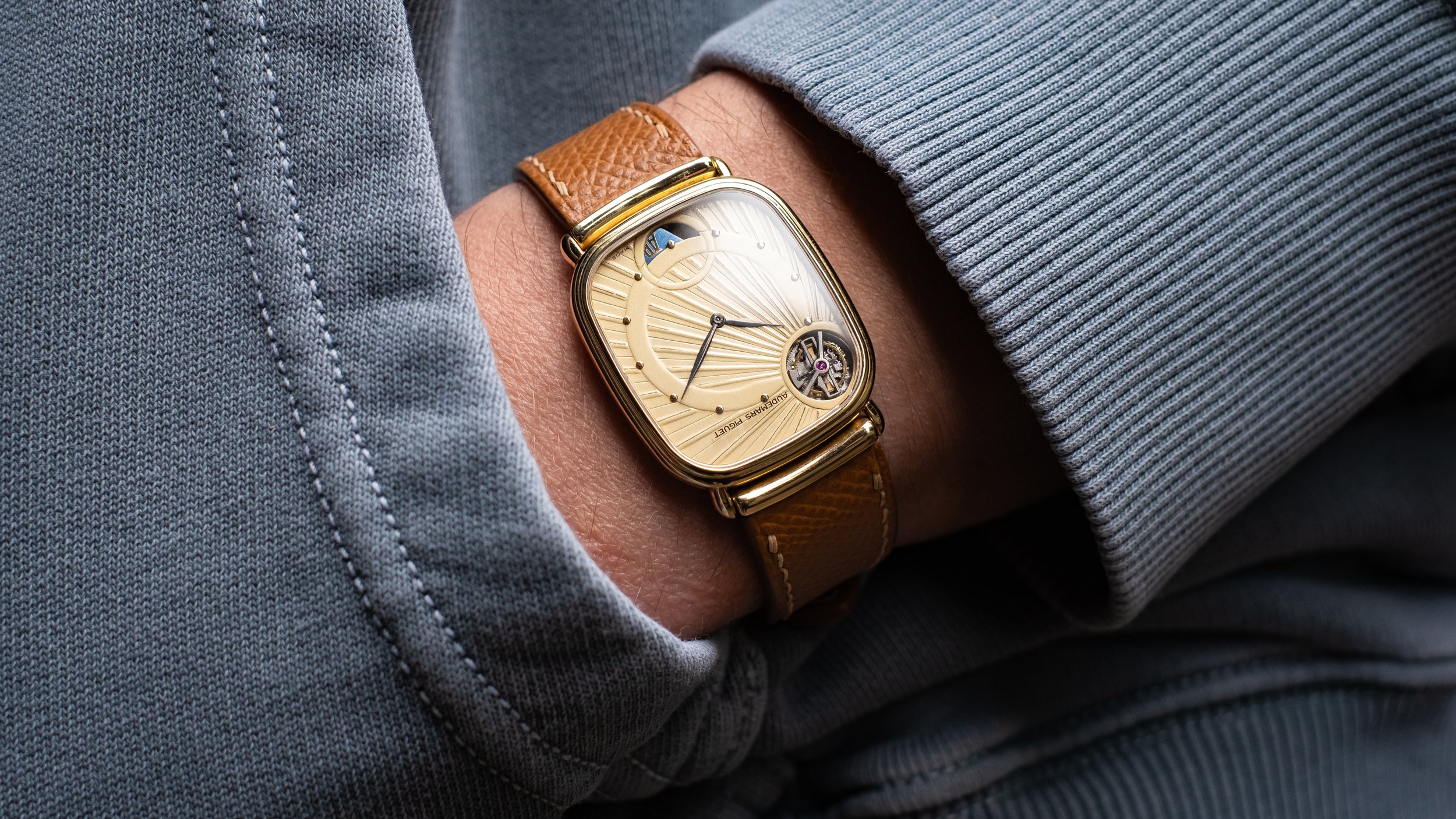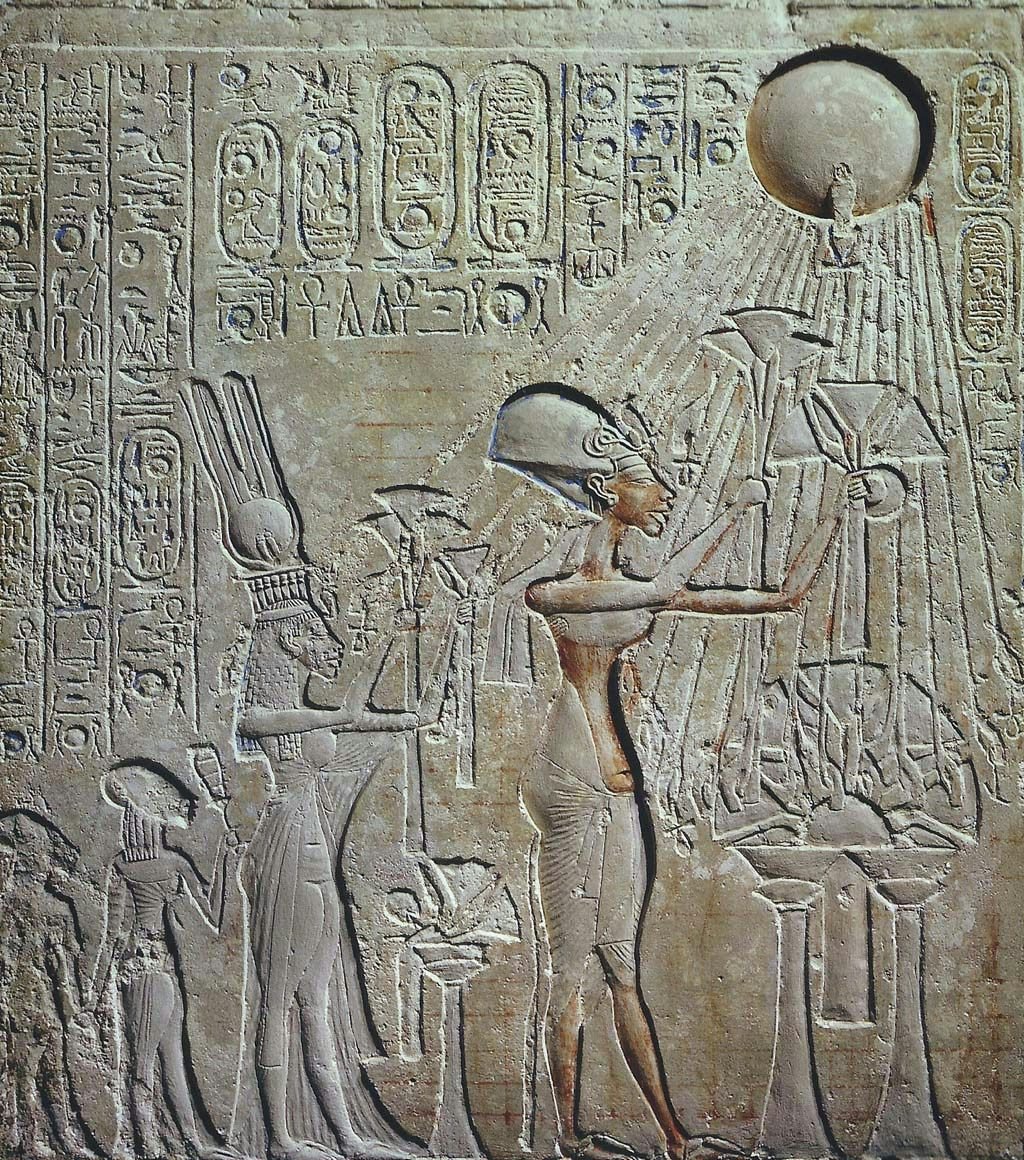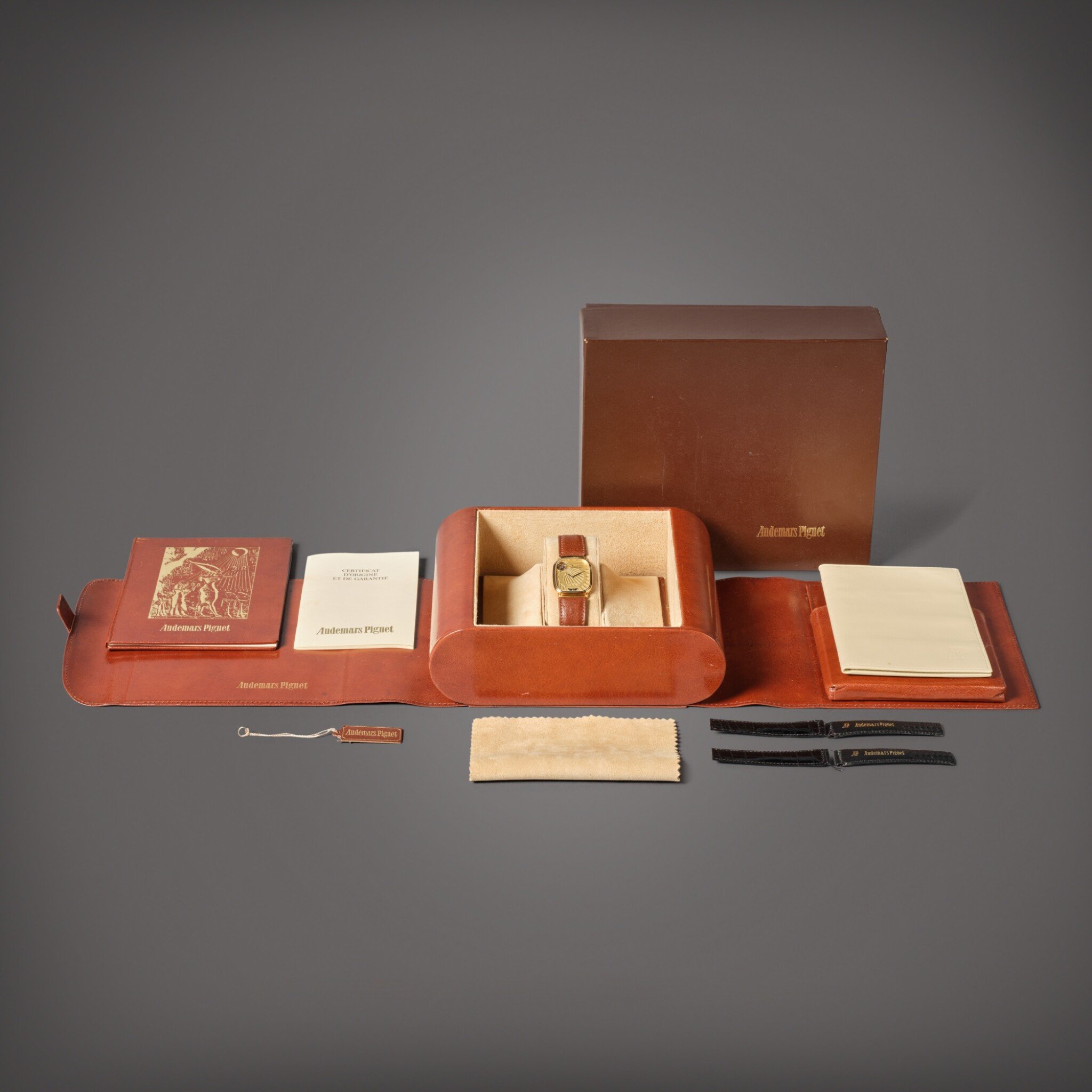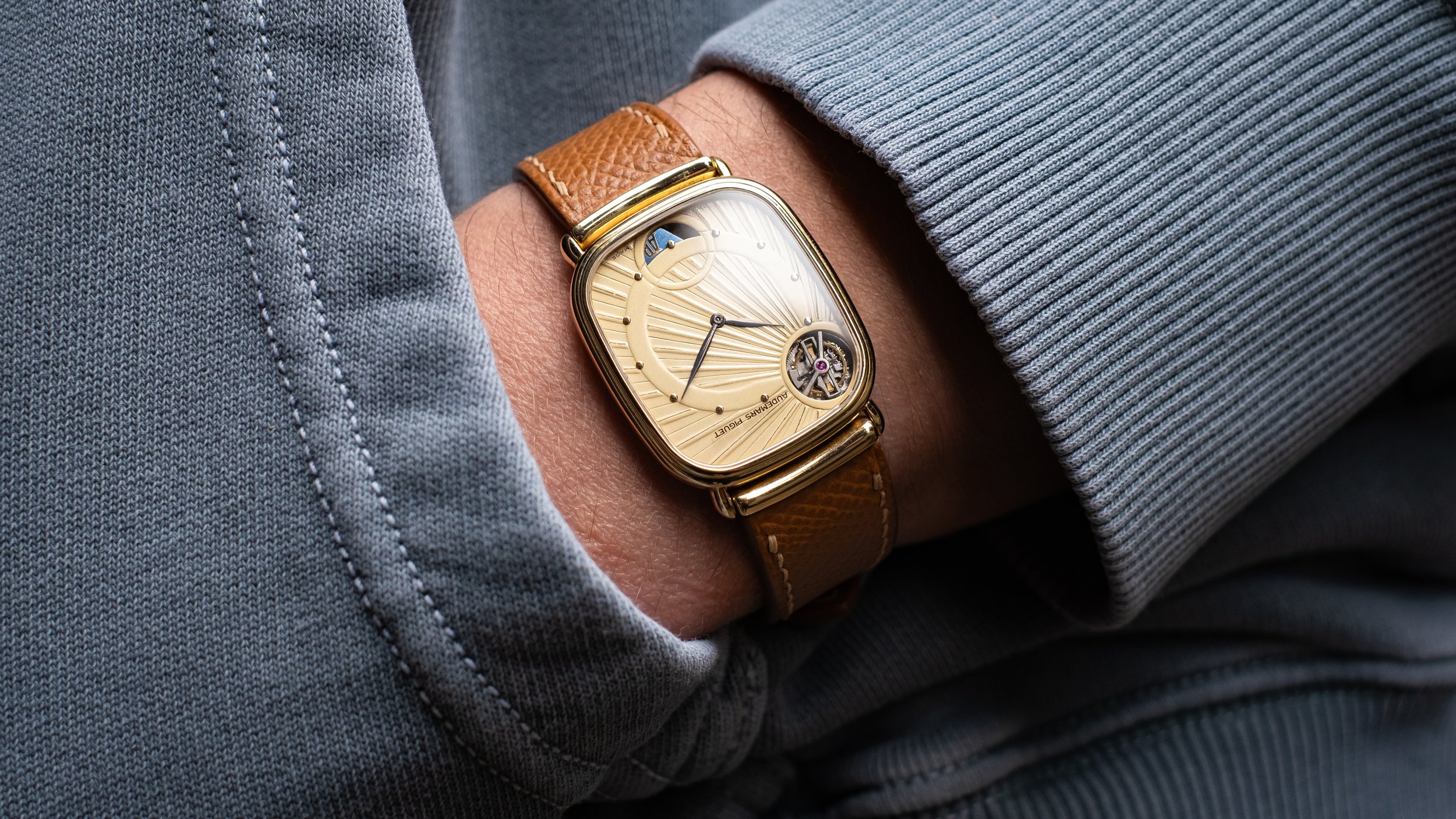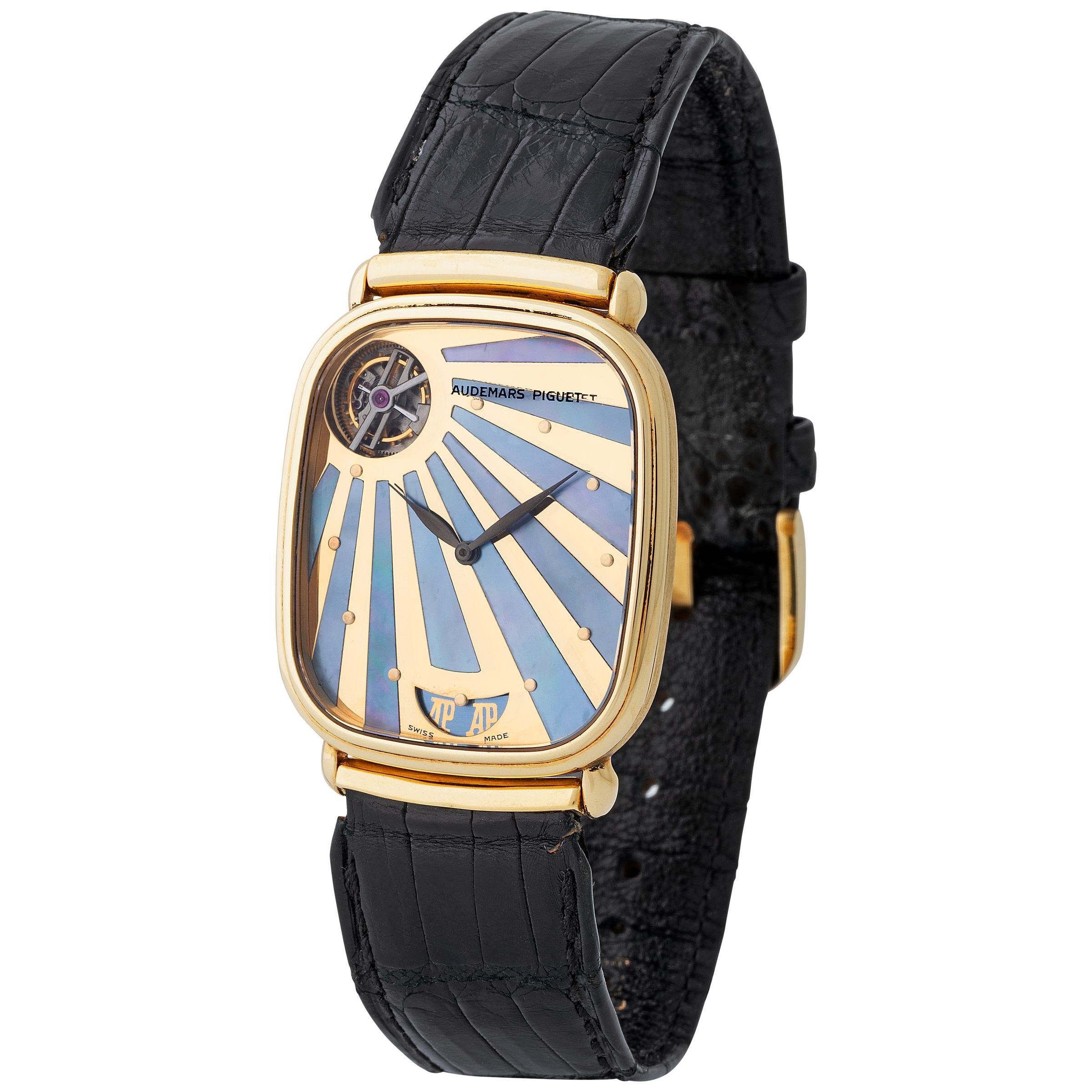Reference Talk — Audemars Piguet Ultra-Thin Self-Winding Tourbillon Ref. 25643 and 25656
Tim Vaux photo for WBLDN
A Quartz Beginning
It was the late 1970’s and quartz watches were all the rage, mass produced and inexpensive. Movement constructor Maurice Grimm and Project Manager André Beyner of Ebauches SA were tasked with coming up with something special to help the company survive and stay afloat in a very competative market. Their goal… to produce an electronic watch that stood out from the swarm of current offerings, there were only two relevant categories in quartz: miniaturisation and precision.
The result was groundbreaking for the industry, the worlds thinnest electronic watch, made for Ebauches SA and ETA. Utilising the caseback as the mainplate, machined to house the components, they were able to drastically reduce the thickness of the watch and in the process making the worlds thinnest electric watch (less than 2mm). The case was manufactured by Favre Perret, a little known fact from the master of this era of watchmaking, Plus-Ultra.ch, who contributed heavily to the making of this article.
On January 12, 1979, at press conferences around the world, Ebauches SA and ETA, together with Concord, Eterna, IWC, and Longines announced the world's thinnest watch… measuring just 1.98 mm thick.
- WikiWatch
On January 12, 1979, at press conferences around the world, Ebauches SA and ETA, together with Concord, Eterna, IWC, and Longines announced the world's thinnest watch. Measuring just 1.98 mm thick, the three manufacturers introduced remarkably similar watches. All were powered by the ESA Cal. 999, the name given to the pair’s creation.
The ESA Cal.999 had been developed in under 2 years and required the world's smallest battery; developed by ETA subsidiary Renata, Battery No. 32 measured just 6.8 mm diameter in 1.1 mm thick. The watch lacked a crown, using a push on the caseback to set the time and change the timezone. - WatchWiki
The Delirium I was launched in January 1979. It measured just 1.98 mm thick overall and had a rectangular case measuring 24.50 mm across and 29.60 mm lug-to-lug. The synthetic sapphire crystal was 0.28 mm thick. It was sold by Concord, Eterna, and Longines under the names Concord Delirium, Eterna Espada, and Longines Quartz. IWC also offered this model as their Ref. 3000 IWC Quartz.
Further Delirium Development
Concord Delirium IV
Roughly 6 months later Ebauches SA announced another Delirium model, Delirium II, that measured just 1.44 mm thick. Eterna marketed this as the Linea Quartz Skeleton while Concord called it the Delirium II. The following year in Jan 1980 the Delirium III was introduced, measuring 1.68mm, slightly larger than the Delirium II that due to the ultra-thin design, was intended only for collectors not the wider market. Finally the Delirium IV was introduced at the end of 1980 in December. Measuring 0.98 mm thick it remains the thinnest watch ever produced. To make the watch so thin the dial has revolving discs with a marker to tell the time instead of hands, there was also a special battery developed at just 0.8mm thick.
Variants of the Delirium were offered under slightly varying names from Concord, Eterna, Longines and IWC. Detailed writeup from watch-wiki here.
ETA S.A. Delirium, Europastar
Concord Delirium through the ages
Time to go Mechanical
Ebauches SA logo on the prototype dial, Phillips
The introduction of Electro Discharge Machining (EDM) was a massive breakthrough for the manufacturing industries of the early 1980s. Controlled by numerically controlled (NC) computers, EDM enabled parts to be made with finer tolerances, opened up the possibility of stressing materials, and allowed the creation of incredibly fine components that would have otherwise had to have been painstakingly finished by hand.
Although not initially adopted widely within the Swiss watch industry, some saw the great potential of the use of this technology, in particular André Beyner and Maurice Grim. Fresh from breaking the record for the thinnest ever wristwatch at Ebauche SA, with the quartz Delierium, they saw benefit of applying these new technologies alongside what they had achieved to mechanical watchmaking, namely by designing a self-winding watch.
Specifically, they believed they could reduce the thickness of a watch by rearranging the movement, and using the case as a mainplate. They also implemented an ingenious ‘hammer’ winding rotor which unlike traditional automatic watches’ 360 degree rotation, only required a 15 degree swing that was made possible by the use of two of the heaviest metals in platinum and iridium as the pendulum. EDM machines made this type of creation feasible, where previously it would have been impossible to make such precise and finely finished parts with traditional machinery.
However, despite a patent being filed in 1980 under Ebauche SA, the perceived lack of demand for such a product meant that it went no further and was rejected by the company.
For more detail we encourage you to read James Dowling’s fantastic article Disruptive Thinking for Revolution, on this topic.
Drawings showing plans for the oscillating weight pivot, Audemars Piguet 20th Century Complicated Wristwatches
The People’s Tourbillon
Project P29 no.11 prototype - pre 1986, Philip’s
Despite a mechanical time only watch never getting off the ground for Beyner and Grim, developments in EDM over the next 3 years meant they were able to take their ideas a step further – not deterred by their setback they got to work on the creation of a tourbillon that would be the smallest and lightest ever made. After a year they had succeeding in creating a tourbillon which was just 7.2mm in diameter, made possible by the precision of the new technology.
The next step for them was to apply this creation to a wristwatch, namely by adding a tourbillon to their designs for the ultra-thin self-winding watch that had been mothballed 3 years earlier.
With significant work, they were successful in creating the first fully working prototypes. It is thought only a handful of prototypes were produced, each with an open dial with the self winding rocking hammer at the top and tourbillon cage bottom right.
This laid the foundations for the first ever serial production of a wristwatch tourbillon and was a trailbrazer in the pursuit of mass production for such a complication across the Swiss watch industry.
Enter Audemars Piguet
Brushed finish like sun-rays - radiating from the tourbillon, Watches by SJX
It may seem hard to believe now with so many different tourbillons on the market, but in 1986 tourbillon wristwatches were still unbelievably rare, with no more than a handful in existence
- Jack Forster for Hodinkee
Despite creating a working prototype, and demonstrating that machinery made series production possible, the issue remained over which company would invest in a project of this kind.
It is worth noting that up until this point, tourbillons were not something that appeared commonly in wristwatches, let alone on a serially produced scale, and as a result were not something a consumer could easily buy. Accoridng to James Dowling, amazingly only 20 wristwatch tourbillons had ever been made before this point.
Under the leadership of Georges Golay, Audemars Piguet were already taking big bets on high end mechanical watchmaking, notably with the Royal Oak and Ultra Thin Perpetual Calendar. It was Golay who chose to ‘roll the dice' and subsequently bring to life the first self-winding tourbillon wristwatch at scale for the first time in the history of watchmaking.
Audemars Piguet Prototypes
AP prototype, Audemars Piguet 20th Century Complicated Wristwatches
There have been just a few images surface of the early Audemars Piguet prototypes, there is also one proudly on display in the Museum in Vallée de Joux. Above are two variants that have been seen, firstly a fully integrated version courtesy of SJX (below the section title) and secondly a strap variant more inline with the final model (just above), signed Prototype no. 3. Note that the brushed finishing of the AP prototypes radiates from the tourbillon, perhaps reflecting the sunray inspiration for the final design.
The first AP tourbillon dial... possibly
A loose and never before seen dial. Interestingly you will note the layout is aligned with the prototype orientation above, with the tourbillon cage bottom right, but in the style and shape of the final product. This suggests it may have been an early prototype design.
Unlike the other roman numeral dials seen, this dial is adorned with ‘tourbillon automatic’ in two rows of text at 6 o’clock.
If you have seen this dial fitted to a watch, or have any further information, please let us know, we’d love to hear from you.
Early prototype dial
Introducing the Reference 25643 & 25656
ref. 25643 = strap, WBLDN
ref. 25656 = bracelet, Christie’s
The first self-winding tourbillon wristwatch in the history of watchmaking.
It was in 1986 at the Basel Watch Fair that Audemars Piguet unveiled the multi record breaking masteriepece. The world’s thinnest automatic wristwatch tourbillon, the world’s smallest and lightest tourbillon, and the first ever with a front facing tourbillon cage: the reference 25643.
Initially in yellow gold and later in platinum, the design was striking to say the least, the layout of the watch somewhat inverted from the original prototype with the exposed blued AP self winding hammer now sitting at 6 o’clock and the tourbillon top left.
The aperture at 6 reveals the hammer winding weight in blue with the AP logo - a deliberate choice in order to proudly display that a watch as thin as this was indeed automatic.
The Designer & the Design
Circa 1985. Jacqueline Dimier, AP Chronicles
The brilliant Jacqueline Dimier had joined AP in 1975 and was responsible for the design of the first ladies Royal Oak in 1976 amongst many other projects. She would later go on to design the world’s first wristwatch tourbillon produced in series, which would be launched in 1986.
Jacquieline Dimier, an integral part of Audemars Piguet, having designed the first ladies Royal Oak and the Quantieme Perpetual, was tasked in creating the design for the groundbreaking self-winding tourbillon.
There are a couple of rather intertwined explanations for the design inspiration.
Thought to derived from an Egyptian relief carving of the Paraoh Akhenaten and his wife, Nefertiti, who became famous (very) posthumously in Western culture as the parents of the Pharaoh Tutankhamun. King Tut, in 1986, was a very big deal in popular culture as one of the largest, and first, blockbuster museum exhibitions ever mounted – The Treasures of Tutankhamun – had only recently finished touring in 1981.” - Hodinkee
Interestingly the 20th Century Complications Book by Audemars Piguet describes the inspiration being taken from Astronomy. In the book it explains how the tourbillon cage is representing the sun with its rays falling onto the dial, the 12 circular hour-markers representing the planets.
The Egyptians were known for their keen interest in astronomy and to further the connection the booklet with boxset features the carving design on the front (see below).
Fulls set ft. Egyptian carving on the booklet, Sotheby’s
Caliber & Construction
Audemars Piguet named their movement the caliber 2870.
The complexity of movement and dependency on the new EDM technology meant Beyner and Grim’s prototyping company would make the watches using their state of the art machines and Audemanrs Piguet would assemble the movement, retaining the original and revolutionary Beyner and Grim movement design.
The unique construction of the Caliber 2870 is a significant reason why it’s often identified solely by its caliber number rather than a model reference. In this design, the movement isn’t merely a component; it essentially constitutes the entire watch.
Caliber 2870, construction breakdown, Time in Gold
The caliber 2870 has no bridges or top plate instead the pivots for the automatic winding system and gear train run in jewels that are set into the case back, which functions as the top plate of the movement. This construction allows for an ultra slim case/watch of just 5.3mm thick, or should we say thin.
It has been noted that the movement was so complex and complicated that about 150 hours per watch were required at Audemars Piguet to finish it.
Dial removed exposing movement, Unknown source
Hammer/Bumper Self Winding
The cal. 2870 used a self-winding hammer system, inspired by the first 18th century self-winding watches. The result was the first 'hammer’ winding tourbillon in history.
Although this type of mechanism is not particularly efficient, it can be very compact, with the hammer in this instance cut into the backplate/case to further decrease thickness.
To wind the watch, the hammer rotor swings from from left to right, limited to a movement of just 15 degrees. Winding from such a small movement was only made possible by the pendulum being made from two of the heaviest and densest metals known – platinum and iridium, in line with the original prototype designs. This generates a winding reserve of 50 hours. As noted previously, the aperture at six o’clock reveals the hammer, with the AP logo.
Crown position and exposed jewels
The crown is positioned on the back of the watch and serves time setting only. From the pic you can see the jewels exposed with the case back serving as the base plate of the movement. The gear train and rotor are mounted on the case back.
Also on the back the individual series number can be found, shown here is no. 278 sold by WBLDN this year. The hallmarks are also visible for the 18k yellow gold case.
Crown on the back, jewels exposed, WBLDN
Tourbillon cage mounted with the escapement, Revolution
Tourbillon cage
The smallest turning frame ever in the 200 year history of the tourbillon was built for these wristwatches, with a diameter of 7.2 mm and height of 2.5mm.
The tourbillon cage is made from titanium, extremely light and stable, weighing in at just 0.123 grams, leading to improved efficiency of the movement. A full rotation is made every 50 seconds.
Titanium was notoriously hard to work with, with this the first use ever recorded of such a material in tourbillon manufacturing. This was only made possible by computer-directed electroerosion technology.
Production Numbers
& Models
The difficulty in producing such a small and complex movement meant that production was confined to relatively low numbers; over the 6 year production period from 1986 and 1992 according to AP’s records only 401 examples were produced, amounting to an average production of just 67 watches per year. To put this into context, AP’s flagship Quantieme Perpetual complication was produced over a 15-year period (starting in 1978) and totalled 7219 examples, making the average yearly production approximately 7 times higher at just over 481 per year.
Audemars Piguet 20th Century Complicated Wristwatches
Of the two production references equipped with the calibre 2870, the reference 25643 had the higher production with 360 made in yellow gold (BA) and in 22 in platinum (PT) separately numbered; these watches were delivered from 1986 up to 1999, nearly 7 years after production ceased. Platinum was delivered in a short window within this period, notably from 1990 to 1993 and is consistent with it’s relative rarity.
The reference 25656 (equipped with integrated bracelet) was made in just 19 examples, with 18 of those in yellow gold (BA) and 1 in platinum, delivery was made from 1987 to 1996. No examples were ever made in pink or white gold in either reference.
Ref. 25643 Models, Audemars Piguet 20th Century Complicated Wristwatches
Ref. 25656 Models, Audemars Piguet 20th Century Complicated Wristwatches
Distribution
According to AP almost half of the 401 watches were distributed in Europe, around one third in Asia (including 16% of the total in Hong Kong), 15% in the United States and less than 5% in the Middle east.
Variants
Firstly, understanding the reference numbers for the AP Tourbillon
Example reference 25643BA.OO.D002CR.01
Lets break it down…
25643 = Core reference (4-5 figures)
BA = Case material (2 letters) e.g. 18k yellow gold
OO = Standard decoration (decoration), EE for example refers to Emerald stone decoration
D = Buckle if leather strap - A or D is used in this reference - A is pin buckle, D is Deployant
002 = Bracelet (colour code of model number) e.g. XXX
CR = Strap material - (2 letters) e.g. croc
01 = Dial - (2 numbers) e.g. solid gold dial, no mother of pearl
Further reading AP Chronicles website
Dial Variants
Yellow Gold (BA) Model
For the 18k yellow gold model this is the most common dial, the classic ‘sun-ray’ design featuring high polish edges on the embossed rays. For this dial variant in yellow gold it is thought to be dial code .01. This dial has been seen across both ref. 25643BA and ref. 25656BA.
Ref. 25643BA with .01 dial, WBLDN
Mother-of-Pearl Variants
Two mother-of-pearl dial options have been spotted, firstly a gold dial with embossed MOP sun-rays and secondly a MOP base dial with matte blue sun-rays (this dial is flat - no raised/embossed rays). Both of these are relatively rare to see with the first also having been spotted on the ref. 25656 in the wild.
18k yellow gold dial with MOP embossed rays, Monaco Legends Auction
MOP dial ‘flat’ matte blue rays, Quill and Pad
Dial codes for these are a little tricky as the AP Complications book appears to contradict itself giving multiple dials the same code. From what we have been able to decipher it appears the gold base with embossed MOP sun-rays is dial code .02 and the MOP base with matte blue sun-rays is dial code .03.
On all three of these examples the Audemars Piguet logo is applied to the crystal of the watch, and is not found on the dial itself.
Variants yet to Appear …
Below are two incredibly rare, maybe not even produced, 25643BA dials. The left featuring a guilloche centre with black outer and arabic numerals. The right featuring an off white somewhat silvery dial, we have seen this dial in person albeit loose, not fitted to a watch. Note how both dials feature the AP logo in different formats actually on the dial vs sitting on the glass above as per the previous example.
Both incredibly interesting for different reasons and dial codes unknown, again the Audemars Piguet 20th Century Complicated Wristwatches Book sprinkles a little more confusion denoting both .01 dials. If you have either of these dials we’d love to hear from you.
Guilloche center and black surround
Shimmer white finish and roman numerals
Platinum (PT) Model
Interestingly the platinum models appear to feature mother-of-pearl (MOP) only, we’re yet to see a plain platinum dial or any quirky alternative such as the guilloche above. Both dials available are undeniably beautiful and again follow the same format as the yellow gold variants.
First up is the white metal dial with embossed MOP sun-rays, secondly the MOP based dial with the matte blue sun-rays (flat dial surface).
White metal dial dial with MOP embossed rays, Sotheby’s
MOP dial ‘flat’ matte blue rays
As for dial codes all we have to go off here is the MOP based dial with matte blue rays as .01 in the Audemars Piguet 20th Century Complicated Wristwatches Book shown in above image, although this may not be reliable.
Strap Variants
Leather with hooded end-links
Removable lug hoods, AtelierTempus
Back of the lugs, Watches of Knightsbridge
There appears to have been a number of original leathers sold with the watch, from croc to calf typically in black or brown with dark blue for platinum. Often seen with 'hooded’ end-links that are removable, it is not uncommon to see a watch being listed without them, interestingly the Audemars Piguet 20th Century Complicated Wristwatches Book implies that later models didn’t come with these end-links.
Where hooded lugs are included, they are removable to allow for easy strap changes and fitting custom straps. In the reference number you can find the strap code e.g. 001, 002, 003 etc. Following the strap code is the material code e.g. CR for alligator. We’re struggling to decipher how the strap colours relate to the strap code, if you have documentation on this we’d love to add here.
Original brown calf skin leather, Bonhams
Deployant and Pin Buckle
The ref. 25643 has been spotted with both 18k yellow gold double sided deployant (pictured below), as well as a more simple 18k yellow gold pin buckle. Both are correct for the model and can be identified in the reference number.
The deployant has appeared across a number of model lines including the Quantieme Perpetual. It features a double folding system with the AP logo present when closed. For the deployant the OEM strap requires cutting for adjustment. The original leather straps come with notches to allow easy measurement and fitting.
Deployant clasp, WBLDN
Pin buckle, Watches of Knightsbridge
Integrated Bracelets
The integrated bracelet tourbillon had a different reference to the ref. 25643 and goes by ref. 25656 identifying the model as an integrated bracelet reference.
The case shown below differs from the strap variant to allow for easy connection to the 9 link bracelet. These bracelets, we believe, came in only 2 styles (please prove us wrong here), all metal bracelet code is 765 and metal with MOP inlay has a bracelet code 755 within the full reference number. There was 1 platinum tourbillon delivered with an integrated bracelet, it is not currently known what bracelet type this was delivered with.
No A or D is present in the full reference number of the integrated bracelet model.
Solid metal bracelet, bracelet code 765
Mother-of-pearl center links, bracelet code 755
AP are renowned for using interesting materials in their bracelets, an example can be seen here with pearl used as the material for the 3 centre links. This design is also witnessed in Quantieme Perpetuals produced around the same time.
18k yellow gold and mother-of-pearl, bracelet code 755, tradewatches.com
AP logo clasp on bracelet code 755
Further Reading
Online
Disruptive Thinking — by James Dowling for Revolution Watch
PlusUtra.ch Blog — by Manuel, renowned collector and dealer
WatchWiki — Incredible source of info for the Delirium
Hodinkee — by Jack Forster
WatchCrunch — by Paul (incredible read!)
Books
Time in Gold - Viola and Brunner
Audemars Piguet 20th Century Complicated Wristwatches - AP museum
